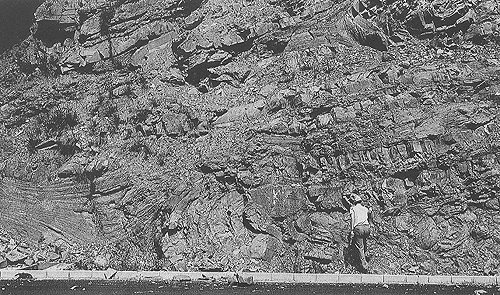

Folded beds in a paleoslide
Plate 132


Folded beds in a paleoslide
Plate 132
We have already seen that folded structures tends to characterize slides made of heterolithic units, where the interbedding of more and less competent beds provides optimal conditions for the development of numerous surfaces of slippage. However, shear planes not only contribute to folding but also break the continuity of bedding. With deformation proceeding, disarticulated fold hinges are piled up in the style shown by this picture. Some features are worth pointing out in them. One is the parallelism of axial planes, dipping to the left and making a small angle with the horizontal plane. Possible ways of obtaining this recumbent folding are sketched in the inset (the structures are also called slump overfolds ).
Another characteristic is the thickening of sandstone beds in the hinges of folds, which suggests some flow of sand during deformation. Finally, the hinges are bracketed by banded mudstones in a sort of fork or wish-bone pattern (see lower left and upper right). Banding is a secondary character, acquired by viscous flowage.
The outcrop is part of a major slide mass, more than 100 m thick, interbedded in the Marnoso-arenacea Formation, northern Apennines, road connecting Palazzuolo sul Senio to Passo Sambuca (Florence).
| Photo: G. Piacentini 1970. |